Lord Siva Nataraja: The Cosmic Dancer
BY: SASANKA S. PANDA
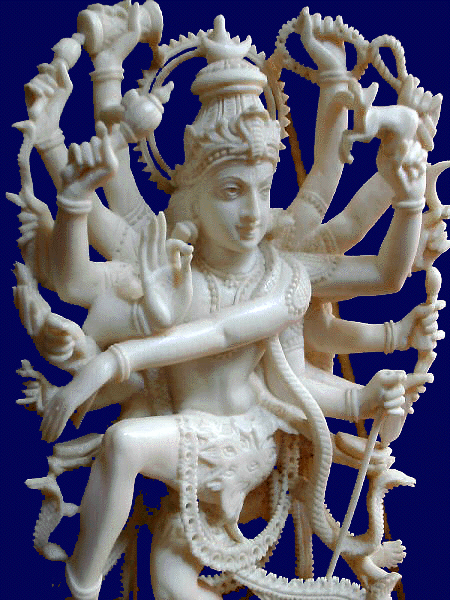
Jan 12, ORISSA, INDIA (SUN) — In Bharata's Natyasastra there is mention of one hundred and eight types of dances, which synchronise with the number of dances, stated in the Saivagamas. Lord Siva is the great master of dances, Nataraja, the Cosmic Dancer, who danced in one hundred and eight modes, as mentioned in the Saivagamas. According to the ancient text Amsumadbhedagama, the image of Nataraja is to be sculptured according to the Uttamadasa-tala measurement, depicted as dancing by keeping the front left hand either in Gajahasta or Bhajangatrasita posture.
The Apasmara Purusa should be trodden on by Lord Siva. Nataraja should be accompanied by His consort Parvati in His left side. We get description about Nataraja image in other texts like Uttara Kamikagama and Silparatna also. [1] The significance of the mystic dance of Lord Siva has been elaborately discussed explaining the mystic nature of the dance by the noted art historian Dr. Ananda K. Coomaraswamy. [2]
The earliest Nataraja image of the upper Mahanadi valley is found in a high relief at Vaidyanath, now lying in two pieces in the Kosalesvara temple precinct. It is of the height of around six feet and most probably fitted to the pillared Jagamohana in its original state. It is a ten-handed image of the Lord, depicted as dancing in the Chatura mode, by putting his left foot on the back of the Apasmara Purusa, which is lying below. He is holding a long Sarpa in both his upper-most hands over his head. Most of his hands are broken. In the remaining right hand is a Dambaru, while an Aksamala and a Kapala are in two of his intact left hands. His Vahana the Nandi bull is seen in the standing posture behind his legs. His consort Parvati in seated position and a bearded Gana are seen beside his right and left legs respectively on the pedestal. A spoked Prabhavali is behind his head. From the iconographic point of view this image can be dated to the Panduvamsi period, i.e. late 8th or early 9th century A.D.
Another excellently carved ten-handed Nataraja image, also depicted as dancing in the Chatura mode is in situ, found fitted on a stone-slab in high relief in the proper north side of the interior wall of the pillared Jagamohana of the Kapilesvara temple at Charda in Sonepur district. In this image, the Lord's major left hand is in the Gajahasta posture, while the major right hand is in Kataka mudra.
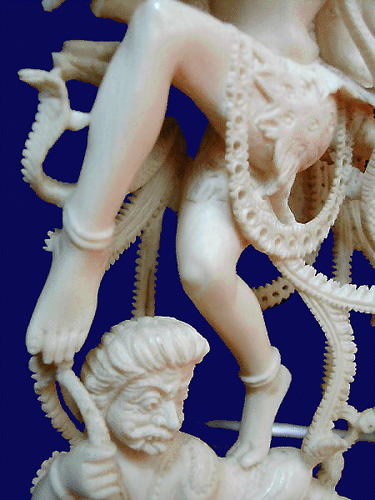
In his upper-most up-raised hands he is holding a long Sarpa over his head. The Lord is lifting the chin of his consort Parvati in one of his lower right hands. In his remaining right hands are Aksamala and Dambaru, while in one of his left hands is a Kartri. The Lord is Urdhvalinga. He is wearing all ornaments like Hara, Keyura, Kankana, Katibandha and Kundala etc. Floral ruffles are seen above both his ears. A Jatamukuta is adorning his head. His vahana the Nandi bull is seen to be peeping between both his legs. A Gana in seated posture and a devotee with both his hands folded in obeisance (Anjali) in the proper right side, while a dancing Gana in the left side of the pedestal. This image is measuring around four feet and a half in height and two feet in breadth, and can be safely dated to the early 10th century A.D., when the Somavamsi kings were ruling this part of Orissa.
Another image of Nataraj, belonging to the early 10th century A.D. is found amidst loose sculptures, kept in the complex of Ramesvara Group of Temples at Baud town. It is a four-handed image of Nataraj dancing in the Bhujangatrasita posture, with his right leg placed on the back of the Apasmara, and his up-raised left leg crossing his body. Like in the cases of sculptures of the Panduvamsi period, a thin layer of stucco has been applied over the surface of the stone, so as to enable the sculptor to make this image. A flaming Prabhavali or something like matted hair is seen behind his head. The major left hand is in the Gajahasta with the hand pointed towards the uplifted left foot of the Lord. The upraised right hand is in Abhayamudra, and the lower right hand is in Karanahasta posture. He is wearing a scarf loosely around his shoulders, and something like flames are carved in the base portion of the back-slab. The Apasmara is lying below in a prone posture with his face turned downwards. This image can be dated to the early 10th century also, i.e. the early Somavamsi period.
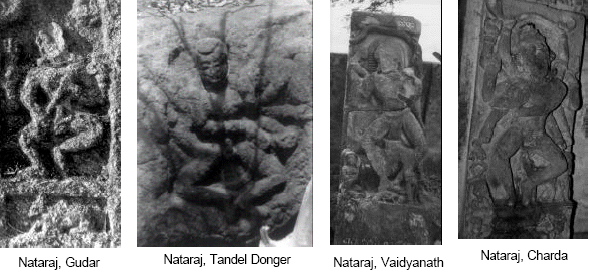
In the hapaethral circular open-air temple of Chausath Yogini at Ranipur Jharial in Balangir district, the images of the sixty-four Yoginis (now only forty-eight Yogini images in situ) are surrounding the central figure of the dancing Siva. Here an eight handed figure of Lord Siva is seen to be dancing in Ananda Tandava on a platform of the height of around two feet. It is a roofed platform and of the height of around seven feet. The image of the Lord is nearly four feet in height. A snake is going around his waist-portion. It creeps up and peeps above his left shoulder. A Jatamukuta is adorning his head and Makara Kundalas are hanging from his ears. He is Urdhvalinga (Penis Erectus). In both of his upper hands, which are raised above his head, he is holding a long snake. The objects in his middle upper and lower right hands are Trisula (small trident) and Dambaru respectively, the Dambaru being placed on his right thigh. In his middle upper and lower left hands are Gada and Aksamala respectively. The lowest left hand is completely broken. His proper right hand is just above the naval in the Gajahasta pose. His left leg is on the back of his Vahana the Nandi bull, whose profiled figure is carved on the pedestal. The right leg is resting upon the toe on the left shoulder of a fourhanded Ganesa, who is dancing below in the same Ananda Tandava posture. In the left lower hand of Ganesa is a Laddupatra, from which he is picking up laddu by extending his proboscis. His lower right hand is in the same Gajahasta pose like that of Siva and in his upper right hand is a Parasu.
Another sculpture of considerable importance, found at Mahagaon situated at a distance of around 20 kms from Ranipur Jharial is a dancing figure of four-handed Siva with Urdhva Linga (Penis Erectus). The upper right hand of the Lord is in Abhayamudra with an Aksamala hanging from it, while the upper left hand is placed on his right thigh. In the lower left hand, which is slightly raised; the Lord is holding a Kapala, while in his lower right hand there is a small Khatvanga. Bull Nandi, the Vahana of the Lord is crouching in a profiled posture behind the Lord and looking up at his master in 'Devaviksanatatpara'. Here the Lord is seen wearing Hara and Aksamala around the body and hanging on his thigh. He is wearing round Aksamala as Kundala also. A crescent moon symbol is carved on the left side of the Jatamukuta and the Lord has a pleasant smiling face. It is an unique figure of the Urdhvalinga dancing Siva and has got much similarity with that of dancing Siva enshrined in the pillared Mandapa amidst the Chausath Yogini at Ranipur Jharial.
Another important sculpture found in the Bad Jagannath temple at Sonepur is that of the eight-handed Nataraja, found plastered and fitted to the wall on the proper left of the entrance to the present Jagamohana. It is an eight-handed figure of the Nataraja performing the cosmic dance in the Katisama mode and is Urdhvalinga. Most of his hands are broken except the top two hands which are raised up, in which, the Lord is holding a Sarpa (snake) over his head. His vahana Nandi is seen standing in profile just behind the right leg of the Lord on the pedestal and looking up at his master by raising its head. The right leg of the Lord is slightly raised and he is about to perform his dance. The front-faced male attendant is standing beside the left leg of Nataraja. The Lord has a tall Jatamukuta above his head. This image is so heavily covered with lime that other details are mostly obliterated. It is of the height of about thirty inches and breadth of fifteen inches. The iconographic feature of this sculpture can be taken to be of around twelfth century A.D.
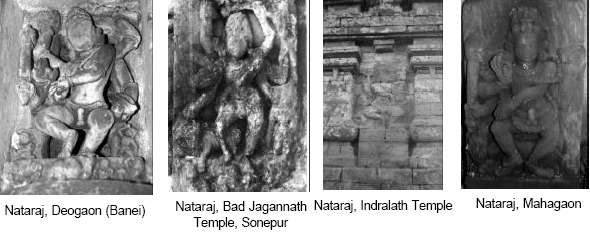
Now, let me discuss about the sculptures, recently discovered in this part of Orissa to study the art form. There is a village named San Dohel, situated at a distance of 5 kms from Khariar in Nuapada district, where an image of four-handed dancing Siva is kept in the house of one gentleman Mr. Krishna Chandra Mishra. It is of the size of around three feet in height and fifteen inches in breadth. Siva is holding a Khatvanga and a Sula in his upper left and right hands, while both the lower left and right hands are in Suchipada and Gajahasta mudras respectively. His long garment is hanging in between both legs. The crouchant bull Nandi is carved in profile on the pedestal, but not in the conventional pose of Devaviksanatatparah. It seems to be an image of the declining phase of art, i.e. 13th-14th century A.D.
Another important image found at Sarsara situated at a distance of 70 kms from Banei town, is a broken image of fourhanded dancing Nataraja with Urdhvalinga (penis erectus).
An image of dancing six-handed Nataraja, fitted in the front facade of the Baneswara temple just above the Dvaralalatavimba of the Antarala connected to the Garbhagrha is of considerable importance. The Lord is holding in his upper-most left and right hands Danda and Dambaru respectively, while in his middle left hand is a Kapala (skull-up). Object in the lowest right hand is a Sula, while the lowest left hand is in the Gajahasta mode. His middle right hand is in Abhayamudra. The Jatabhara on his head is forming a Mukuta. Strings of rosary-beads are forming the ornaments of Nataraja. He is Urdhvalinga and dancing on the back of his Vahana Nandi which is crouching in profile below his feet. A skeletoned Rsi Bhringi is sitting near his left foot on the pedestal, while a front-faced and pot-bellied Gana is sitting near the right leg. Four devotees (Sivaganas) are carved on the pedestal. This unique image of Nataraja is of the size of two feet in height and twelve inches in breadth.
An interesting sculpture belonging to the early Chauhan period, i.e. circa 15th century A.D. is found in the Suvarnameru temple compound. It is that of a dancing figure of fourhanded Siva, which has been taken as his Chandrasekhara aspect; and the other one is that of a fourhanded figure of Parvati seated in Yogasana. The image of dancing Siva is unique. The hair of the Lord is made like ten thick braids of Jata, five falling on each shoulders in both sides. Two snakes are raising their heads in both sides of his head from the hair. His closed eyes give a blissful countenance to the moustached face of the Lord. His body is heavily bedecked with five bands of hara, katisutra, kankana, keyura, kundala, anklets and sarpopavita etc. The Lord is seen dancing on a pedestal with design of a string of beads and a double-petalled half lotus-rosette motif in the centre, hanging from it. In his upper right hand the Lord is seen holding a kuthara, while the object in the upper left hand is not clear. The objects in the lower left and right hands are dambaru and trisula (short trident) respectively. On the pedestal, to the proper right of the Lord, there is a profiled standing figure of his vahana Nandi who is looking up at the master in "Devaviksanatatpara."
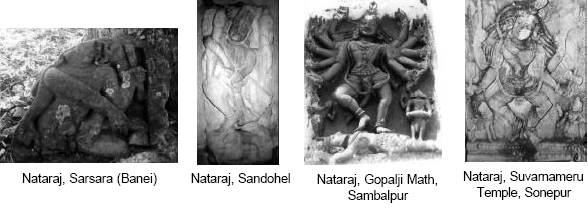
To his proper left is a diminutive four-handed figure of his consort Parvati, standing on the pedestal. The beautiful gown hanging from her waist - portion up to the feet-portion reminds one of the popularity of his dress in the Chauhan royal houses during the medieval period. This unique image of dancing Siva is now kept in the Natamandira of the temple. It can be taken as the figure of Nataraja, not Candrasekhara. To the proper left of the outer gate of the Jagamohan of Radhakrishna temple situated in the Gopalji Math complex at Sambalpur town is an image of Hanuman carrying Gandhamardana mountain, while to the proper right side is fitted a ten-handed Nataraj image seen to be flanked by Vishnu and Brahma in his right and left sides respectively. Attributes in his left hands are Dambaru, Mriga, Ankusha and Dhanu, while in his right hands are Sula and Parasu. In the upper most right hand is the tail-end of the Naga, whose hood is raised over his head.
The Lord, standing on a Visvapadma pedestal, is seen to be holding Parasu and Mriga in his upper right and left hands respectively while his lower right hand is in Varada mudra. His Vahana Nandi bull is near his right leg, and a four-headed figure of Brahma with folded hands is seen to be standing in the left side on the pedestal. The four-handed Visnu in the standing posture holds Sankha and Chakra in his upper left and right hands, and a Gada in his lower left hand, while his lower right hand is in Varada mudra. He is flanked by two handed Sarasvati with Vina and two handed Laksmi on the left and right sides.
In almost all cases the Bhairava images are Urdhvalinga. Even the Nataraja images of Mahagaon, Dungripali (Budhikomna) Deogaon (Banei), Sarsara (Banei), Bad Jagannath temple (Sonepur) and Ranipur Jharial (both of the Chausath Yogini Pitha and the Indralath brick temple) are Urdhvalinga. Mahesvara in the Uma Mahesvara images of Topigaon and Belkhandi are also Urdhvalinga.
Images with Urdhvalinga have been found as early as the Kushana period. Such images are generally found in Assam, Bengal and Orissa. This feature of Urdhva-Retas is defined as the indication of the state of perpetual celibacy. [3] The story of Kamadahana is very popular in Hindu mythology and it describes how Siva destroyed Kama who attempted to distract the Lord who was in deep austerities. [4] Thus Siva is also known in Indian mythology for his supreme control over physical desires.
Like the Ekapada Bhairava and the Saptamatrkas worshipped on a huge monolithic rocky mountain near Ghudar village in the Titilagarh sub-division of Balangir district, an eight-handed dancing Nataraja in Urdhvalinga is carved on a huge monolithic rocky mountain called Tandel Dangar, [5] situated to the west of Dunguripali village near Budhi Komna in Nuapada district. In another monolithic rock nearby a female deity standing in the Alidha position is copulating with a male which is lying flat below with Urdhvalinga. It is called goddess Jharni by the local tribal populace. But it seems to be the rock-cut sculpture of goddess Daksina Kalika, who is generally depicted as having intercourse on the corpse of Siva. The iconography of this goddess corresponds to description found in the Karpuradistotra, giving the Mantroddhara of the deity. In her aspect of Daksina Kalika, she represents the beneficent Grantor of Nirvana: “I worship Kali the Destructress of Kala and Shining One, who is the Bija Krim who is Kama who is beyond Kala and who is Daksina Kalika.” [6]
This procedure of open-air worship of Nataraja alongwith the Matrkas and Yoginis is suggestive of these Pithas possibly used by the Kapalikas for sexo-yogic practices. Learned scholar Dr. H.C. Das has rightly put that “the hypaethral 64 Yogini temple is the expression of intense form of Tantricism, where Nataraja, the central figure is encircled by terrifying images of 64 Yoginis.” [7]
The image of Nataraja is carved in the west Kanika niche on the northern side of the brick built Indralath temple at Ranipur Jharial, in which the major right hand of the Lord is depicted as crossing the body in the Gajahasta mode, while in the up-raised right hand is a short trident. It is an image where the Lord is Urdhvalinga a four-handed dancing Siva is also depicted as Dvarapala in the proper right base portion of the doorjamb to the Garbhagrha of the Dhavalesvara temple at Mohangiri in Kalahandi district. Another four-handed Nataraja image is carved in the Antarala of the Padmaseni temple at Pujaripali in Jharsuguda district. The four-handed Nataraja images can be safely dated to the Panduvamsi period.
A beautifully -carved eight-handed dancing Nataraja image has been shifted from the Siva temple ruins of Dehli in Baud district by the Sambalpur University Museum Authority. Instead of Ekapada Bhairava or Virabhadra, a figure of Vinadhara Siva in the dancing posture is carved in the first carved niche of the rock-cut Saptamatrka panel on a huge monolithic rocky elevation, in a paddy field to the north of the Ghudar village, situated at a distance of 10 kms away from Titilagarh town.
All these Nataraja images of the upper Mahanadi Valley testify to the fact that in between 7th-8th and 11-12th century A.D., the Nataraja Cult was extremely popular in the upper Mahanadi valley of Orissa.
References:
1. Rao, T.A. Gopinatha, Elements of Hindu Iconography, Vol.II, Part-I, Indological Book House, Varanasi, 1971 (Second Edition), pp.223-231 ff.
2. Siddhanta Dipika, Vol.XIII, July 1912.
3. Govindarajan, Hema; The Nataraja Image from Asanpat, article published in Dimensions of Indian Art- Pupul Jayakar Seventy’, Vol.I, ed. by Lokesh Chandra and Yotindra Nath, Agam Kala Prakashan, Delhi, 1986, p.145.
4. Rao, T.A. Gopinatha; Elements of Hindu Iconography, Vol.I, Part-I, pp.147-149ff.
5. Singh Deo, Jitamitra Prasad; Tantric Sculptures in Nuapada District - Orissa, The Orissa Historical Research Journal, Vol.XLII, Nos. 1-4, 1998, p.102.
6. Avalon, Arthur; Hymn to Kali. (Karpuradi Stotra), Commentary by Vimalananda Swamy, Madras, 1965, pp.49-69.
7. Das, H.C., Tantric Saivism in Orissa, article published in “ An Interdisciplinary Approach to Saivism,” ed by Dr. K.C. Mishra and R.K. Mishra, Pub : Institute of Orissan Culture, Bhubaneswar, Orissa, p.134.
